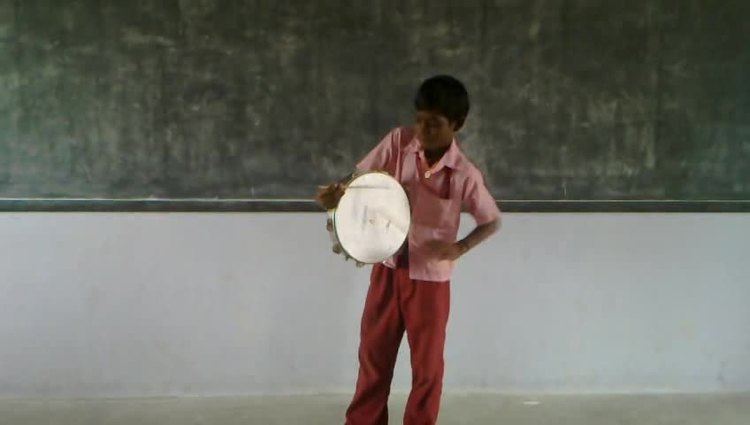 | ||
The Parai (Tamil:பறை) or Thappu (Tamil:தப்பு) is one of the oldest drums used in India, especially in the South Indian state of Tamil Nadu, and also in the northern and eastern parts of Sri Lanka. It is considered as one of the symbols of Tamil culture. In ancient days, this instrument was used as a communication mechanism to convey messages to people and alert against danger. The word Thappu came into practice predominantly during Nayakar's rule in Tamil Nadu. It is believed to be the mother of all skin instruments in Tamil Nadu.
Contents
- Description
- Technique
- Few Well known beats of Parai
- History
- Documentary on Parai
- In India
- In Western Countries
- References
It consists of a circular wooden frame with one end closed with cow skin membrane and the other end open. Thappu is played with two sticks, one being larger and thinner than the other. It is performed in dances, funerals, temple festivals and sport events. Thappu drum or Parai drum is also played to invoke the deities at Madras temples.
Kurunthokai mentions that Parai was used as an auspicious instrument in weddings. It was also used to alert the people in flood time. A type of parai called Ari parai was used in harvest time to make the birds fly off from the fields. Another type of parai called Perum parai is found only in the Kongu Nadu region of Tamil Nadu.
The parai that is played while dancing is called parai aattam Tamil: பறையாட்டம் (Parai Dance), and is also referred to as Adavu Tamil: அடவு. The parai aattam is a folk art in Tamil Nadu.
Description
The parai is a frame drum about 35 centimeters in diameter. It consists of a shallow ring of wood, covered on one side with a stretched cow hide that is glued to the wooden frame. The preferred wood is neem wood although other types may be used. The shell is made up of three separate pieces of wood each in the shape of an arc. These pieces are held together by three metal plates. The parai is played with two sticks: one long, thin flat bamboo stick (approx. 28 cm) called 'Gundu Kuchi' and a short, thick stick called 'Adi Kucchi' that can be made from any variety of wood (approx. 18 cm)
Technique
The parai is slung by a strap over one shoulder (weak/off hand side) and is held vertically by pushing it towards the performer's body. This simple harness allows the drummer to play while standing, walking, or dancing. The Parai is played entirely with two sticks- Adi kuchi (Tamil:அடி குச்சி) and Sundu Kuchi (Tamil:சுண்டு குச்சி).
There are three fundamental strokes from which all of the rhythmic patterns are derived; striking the center of the drum with the shorter stick held in the strong/dominant hand; "slapping" the center of the drum with the long stick held in the weak/off hand; and striking the drum with both sticks, the dominant immediately followed by the off. The short stick (adikuchi) is loosely held between the thumb and three other fingers: index, middle, and ring of the dominant hand. It is held vertically upright, positioned near the lower rim of the drum. The off hand which holds the long stick rests on the upper part of the frame. This stick is positioned at an angle pointed downward. The base of the stick is gripped by the thumb and index fingers and balanced between the middle and ring fingers. The long stick is moved back and forth using the ring finger and thumb respectively
Just before the commencement of every performance, drummers will heat the Parai, holding them extremely close to a small bonfire, so that the heat absorbs the moisture in the drum heads and tightens them considerably. After heating, the drums produce a high pitched loud cracking sound when struck.
Few Well known beats of Parai
History
In Tamil, the word 'parai' means 'to speak' or 'to tell'. It was performed in the courts of Sangam, Chola, and Pandiyan rulers. The drums were used to announce important messages and orders of the great Tamil Kings.
In olden days, parai was used for multiple reasons, ranging from warning people about the upcoming war, requesting the civilians to leave the battlefield, announcing victory or defeat, stopping a breach of water body, gathering farmers for farming activities, warning the wild animals about people's presence, during festivals, wedding, celebrations, worship of nature and so on. Parai has been an instrumental part of the people's life.
Documentary on Parai
In India
Listed below (in alphabetical order) are some Parai music & dance troupes in Tamil nadu
